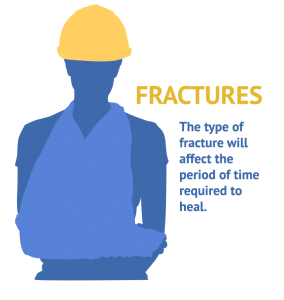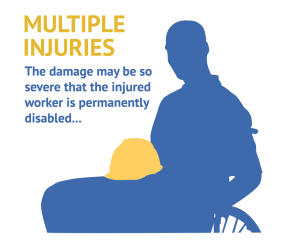People who work in certain industries may face a higher risk of a sustaining a serious injury, but serious or fatal injuries can occur in any workplace.
Reports from the Occupational Safety and Health Administration (OSHA) indicate that the construction industry is most frequently cited for violations of federal safety standards. Increasing numbers of workers are either seriously injured or die each year working at construction sites or in related activity, OSHA reports.
Overall, workers who operate a vehicle as a part of their employment are at a far higher risk of injury. Recent information released by the Bureau of Labor Statistics paints a picture about the most common types of injuries in the workplace.
- Sprains, Strains and Tears
The most common types of work-related injuries are sprains, strains and tears. These injuries affect various parts of the body. Restoring full motion and the ability to function at work can take many weeks, months or longer, based upon the degree of injury. Sprains, strains and tears occur most commonly as part of injuries to the back, shoulder, knee, ankle or wrist.
- Falls, Trips and Slips
 Falls rank as one of the most common and dangerous on-the-job accidents. Falls, trips and slips occur in all workplaces, but the construction industry carries the highest risk, with ladder falls, scaffolding falls and falls from elevations contributing to the high numbers of serious, catastrophic or fatal injuries.
Falls rank as one of the most common and dangerous on-the-job accidents. Falls, trips and slips occur in all workplaces, but the construction industry carries the highest risk, with ladder falls, scaffolding falls and falls from elevations contributing to the high numbers of serious, catastrophic or fatal injuries.
- Back Injuries
Back injuries are common among individuals who work in warehouses, stores and all forms of employment that involve lifting heavy items. The injuries are painful and may be difficult to resolve or treat successfully. The injured worker could miss days or weeks of work. In very serious cases, permanent damage leads to disabilities and the inability to function in the workplace.
- Fractures
 Broken bones are the fourth most common type of work-related injury, often associated with a trip and fall or an incident involving machinery or vehicles. The type of fracture will affect the period of time required to heal. Some work injuries include very serious broken bones that puncture the skin, leading to further medical problems due to the high risk of infection, and difficulty in treating the fracture successfully and restoring full movement.
Broken bones are the fourth most common type of work-related injury, often associated with a trip and fall or an incident involving machinery or vehicles. The type of fracture will affect the period of time required to heal. Some work injuries include very serious broken bones that puncture the skin, leading to further medical problems due to the high risk of infection, and difficulty in treating the fracture successfully and restoring full movement.
- Multiple Injuries
 Some work-related injuries cause damage to several areas of the body, and include fractures, crushed limbs, internal damage, soft-tissue injuries and other types of physical damage. This is the fifth most common type of serious work-related injury. The time it may require to recover could be months or longer, or the damage may be so severe that the injured worker is permanently disabled and will require long-term treatment and care to maintain even the most basic quality of life.
Some work-related injuries cause damage to several areas of the body, and include fractures, crushed limbs, internal damage, soft-tissue injuries and other types of physical damage. This is the fifth most common type of serious work-related injury. The time it may require to recover could be months or longer, or the damage may be so severe that the injured worker is permanently disabled and will require long-term treatment and care to maintain even the most basic quality of life.
Workplace Fatalities in 2013
The most common causes of fatal workplace injuries include transportation incidents, fires and explosions, falls, slips and trips, toxic exposure and contact with objects and equipment in the working environment.
| Total Fatal Work Injuries | Transportation Incidents | Fires/Explosions | Falls, Slips, Trips | Toxic Exposure | Contact with Objects/Equipment |
|---|---|---|---|---|---|
| 4,405 | 1,740 | 148 | 699 | 330 | 717 |
Fatal Work Injuries by Year: New York and New Jersey
| Year | New York | New Jersey |
|---|---|---|
| 2012 | 202 | 92 |
| 2013 | 160 | 101 |
If you have suffered a work-related injury, it is important that you gain access to every form of compensation available. You are most likely eligible for workers’ compensation benefits, but these benefits are limited.
It may be possible to obtain compensation from other sources under certain circumstances. Every serious work injury case should be carefully and fully evaluated by a qualified attorney to determine what options are available for recovering the maximum compensation possible.
Sources:
- Bureau of Labor Statistics – Fatal occupational injuries by industry and event or exposure, All U.S., 2013
- Bureau of Labor Statistics – National Census of Fatal Occupational Injuries in 2013 (Preliminary Results)

Leave a Reply